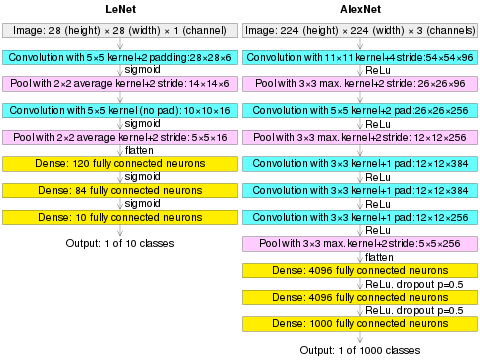AlexNet is the name of a convolutional neural network (CNN) architecture, designed by Alex Krizhevsky in collaboration with Ilya Sutskever and Geoffrey Hinton, who was Krizhevsky's Ph.D. advisor at the University of Toronto.[1][2]

(AlexNet image size should be 227×227×3, instead of 224×224×3, so the math will come out right. The original paper said different numbers, but Andrej Karpathy, the former head of computer vision at Tesla, said it should be 227×227×3 (he said Alex didn't describe why he put 224×224×3). The next convolution should be 11×11 with stride 4: 55×55×96 (instead of 54×54×96). It would be calculated, for example, as: [(input width 227 - kernel width 11) / stride 4] + 1 = [(227 - 11) / 4] + 1 = 55. Since the kernel output is the same length as width, its area is 55×55.)
AlexNet competed in the ImageNet Large Scale Visual Recognition Challenge on September 30, 2012.[3] The network achieved a top-5 error of 15.3%, more than 10.8 percentage points lower than that of the runner up. The original paper's primary result was that the depth of the model was essential for its high performance, which was computationally expensive, but made feasible due to the utilization of graphics processing units (GPUs) during training.[2]
Historic context
AlexNet was not the first fast GPU-implementation of a CNN to win an image recognition contest. A CNN on GPU by K. Chellapilla et al. (2006) was 4 times faster than an equivalent implementation on CPU.[4] A deep CNN of Dan Cireșan et al. (2011) at IDSIA was already 60 times faster[5] and outperformed predecessors in August 2011.[6] Between May 15, 2011, and September 10, 2012, their CNN won no fewer than four image competitions.[7][8] They also significantly improved on the best performance in the literature for multiple image databases.[9]
According to the AlexNet paper,[2] Cireșan's earlier net is "somewhat similar." Both were originally written with CUDA to run with GPU support. In fact, both are actually just variants of the CNN designs introduced by Yann LeCun et al. (1989)[10][11] who applied the backpropagation algorithm to a variant of Kunihiko Fukushima's original CNN architecture called "neocognitron."[12][13] The architecture was later modified by J. Weng's method called max-pooling.[14][8]
In 2015, AlexNet was outperformed by a Microsoft Research Asia project with over 100 layers, which won the ImageNet 2015 contest.[15]
Network design
AlexNet contains eight layers: the first five are convolutional layers, some of them followed by max-pooling layers, and the last three are fully connected layers. The network, except the last layer, is split into two copies, each run on one GPU.[2] The entire structure can be written as: 
- CNN = convolutional layer (with ReLU activation)
- RN = local response normalization
- MP = maxpooling
- FC = fully connected layer (with ReLU activation)
- Linear = fully connected layer (without activation)
- DO = dropout
It used the non-saturating ReLU activation function, which showed improved training performance over tanh and sigmoid.[2]
Influence
AlexNet is considered one of the most influential papers published in computer vision, having spurred many more papers published employing CNNs and GPUs to accelerate deep learning.[16] As of mid 2024, the AlexNet paper has been cited over 157,000 times according to Google Scholar.[17]